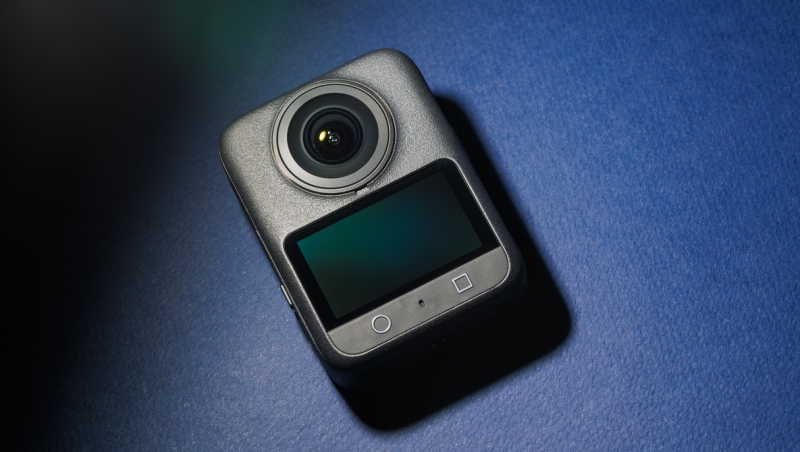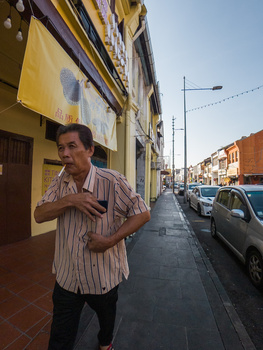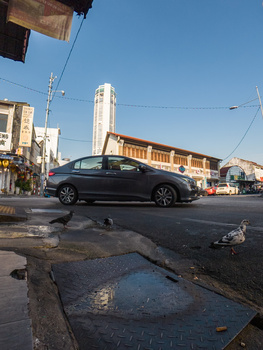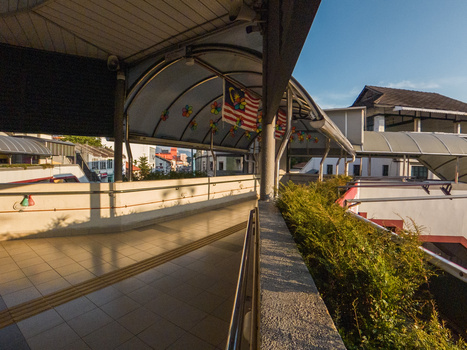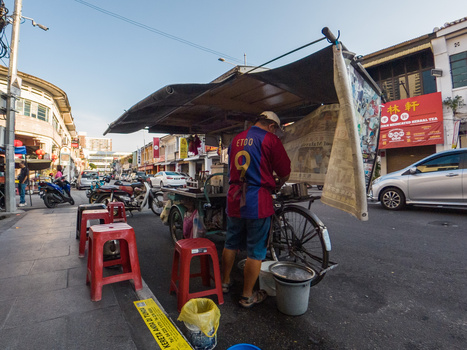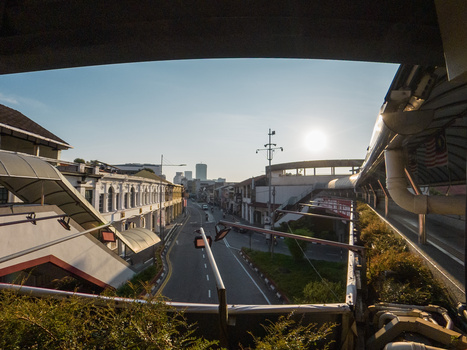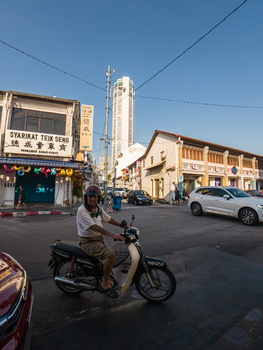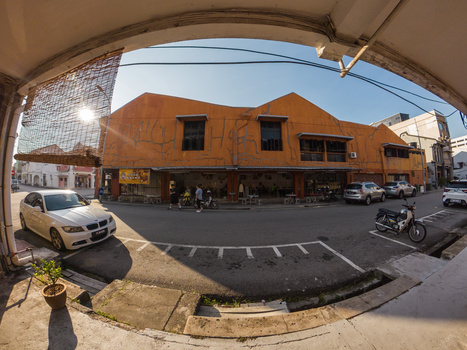Contents
It’s been an exciting few weeks for photography-gear enthusiasts, with product-announcement rumors coming in from every direction. But among all the speculation, as you might already know, DJI has officially entered the 360-degree-camera market with the launch of the Osmo 360.
This bold move is more than just a new product launch; it’s a significant step from a company that has shaped the way we capture visuals with drones. It also challenges the 360-degree-camera market and (hopefully) pushes product innovation to a greater height, benefiting consumers.
Build Quality
My first impression when picking up the Osmo 360 is that it feels remarkably solid in the hand. There is a reassuring density for such a compact camera. Weighing just 183 g with dimensions of 61 mm × 36.3 mm × 81 mm, it’s very pocket‑able, so I wouldn’t mind including it as a fun everyday‑carry—just in case the opportunity to frame something interesting arises. Being a 360 camera, I think of it as sitting at the extreme end—a specialist camera or a “fun‑to‑go” camera. Whether you bring it with a strong shooting purpose in mind or not at all, either works—and its compact form factor encourages it to come out constantly.

Protruding lens on both sides of the camera.
As with all 360 cameras, the dual fisheye lenses on the Osmo 360 are its most vulnerable components. They protrude prominently from the body to achieve that full‑spherical field of view, which also means they’re constantly exposed to potential damage. Using the camera with care is essential, and it’s good practice to keep the protective rubber lens cover on whenever it’s not in use. If you prefer better, all‑time protection, DJI also offers transparent lens protectors that you can leave on during shooting, adding peace of mind. Just make sure the corresponding setting is enabled in the menu to ensure proper image stitching. It’s also worth noting that the Osmo 360’s lenses aren’t easily user‑replaceable, so serious damage could mean a full service. On the upside, I found the lens coating holds up well against fingerprints, reducing the need for constant cleaning during regular handling.
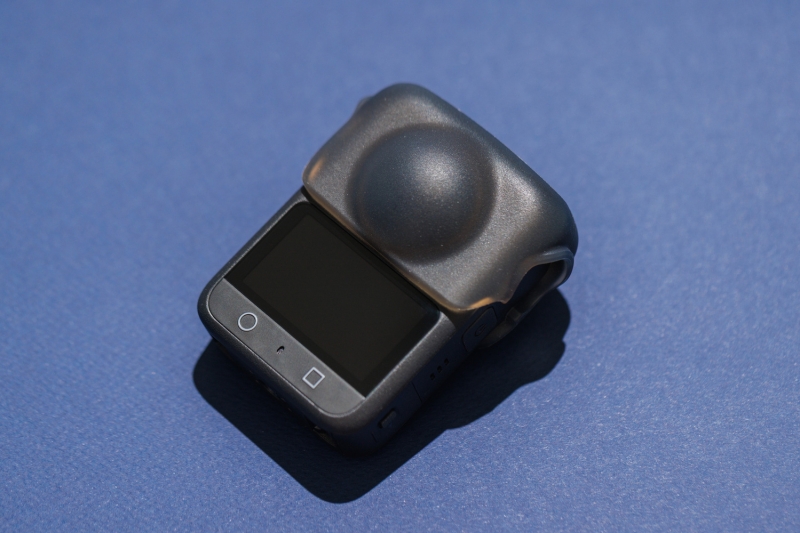
Osmo 360 with protective rubber lens cover on. While the build quality generally feels excellent, the camera body feels a bit too short for a proper grip. It’s not the most natural to hold bare‑handed, and when used without some form of extension, you may find yourself pinching it awkwardly. I’d say it requires two‑hand operation for safety. But then again, this isn’t really designed for handheld use. I suspect the wider, shorter body design caters to a broader horizontal preview screen while keeping size compact and maintaining battery compatibility with the DJI Osmo Action 5 Pro. It’s a small design compromise for a bigger benefit. For those preferring a more compact setup without a selfie stick, I found a cost‑efficient solution: mounting a generic small tripod for easier gripping and quick setup.
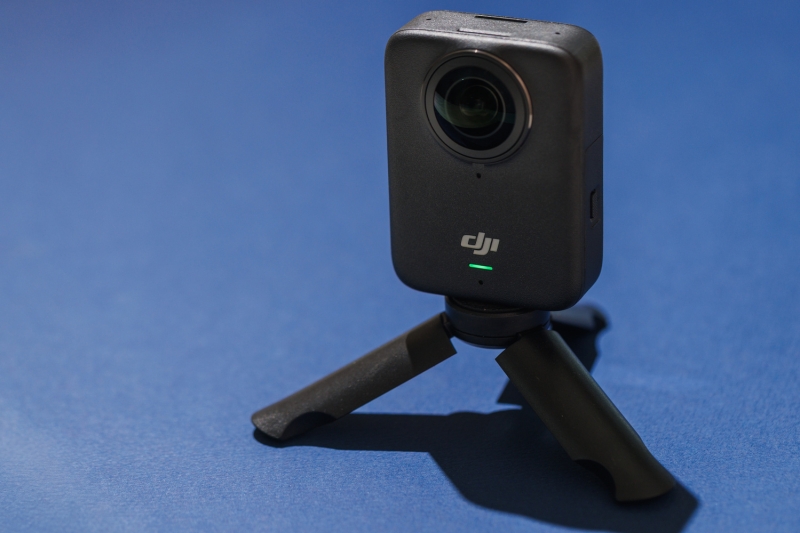
Osmo 360 with generic mini tripod legs for ergonomics and quick setup.
Buttons are clicky, firm, and responsive, though I personally find the shutter button slightly stiff when handheld without accessories. But these solid buttons make sense to prevent accidental recording—especially in a bag. You can access instant recording even when the Osmo 360 is powered off. Press the shutter button, and it begins recording immediately; once you stop, the camera shuts down within three seconds. Note the instant‑recording function defaults to the last shooting mode used before power‑off. Startup time is also impressive—nearly instantaneous if recently used. I suspect DJI implemented a deep‑sleep mode rather than full shutdown, enabling quick wake‑ups; the camera fully powers off only after longer inactivity.
The Osmo 360 is built to thrive in extreme conditions; it has an IP68 waterproof rating, can be submerged up to 10 m underwater, and can record for over 1.5 hours—even in temperatures as low as −20 °C (−4 °F). Despite the rating, DJI doesn’t recommend long‑term underwater shooting or use in environments with high water‑impact pressure—likely a precaution around seals and temperature. I haven’t personally stress‑tested those conditions, so I can’t speak to long‑term underwater durability. That said, all ports and slots are well‑sealed with rubber gaskets, and the construction feels solid.
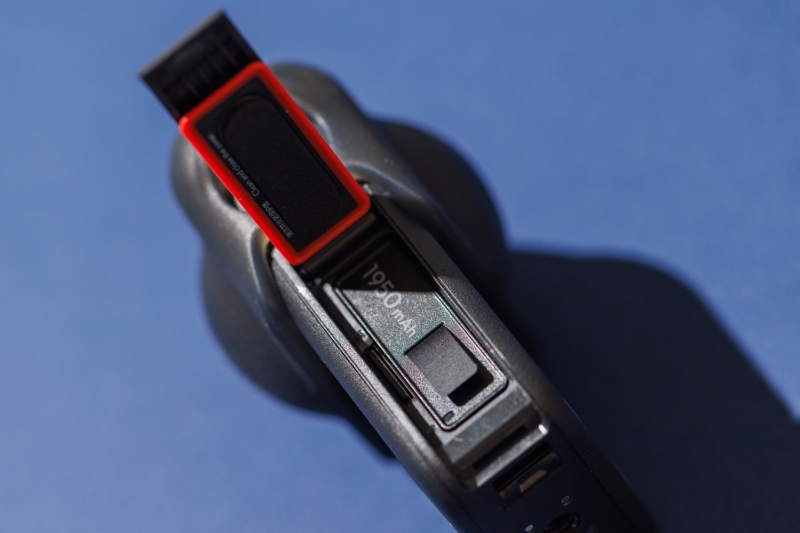
Rubber gasket found below the flap of the battery slot.
Battery access uses a dual‑locking sliding mechanism for extra security. The micro SD card slot is inside the battery compartment, which makes removal tricky without removing the battery. I would have preferred it behind the USB‑C port door—it would make file transfers much simpler. That said, you can transfer files via USB‑C, so unless your card is full and needs replacement, there’s little need to remove it.
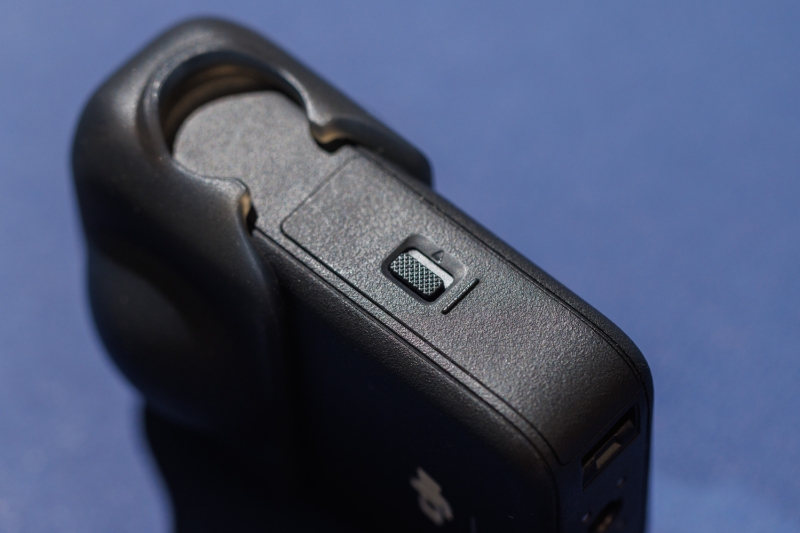
Dual‑locking sliding mechanism. You need to slide right before sliding down to access the battery slot.
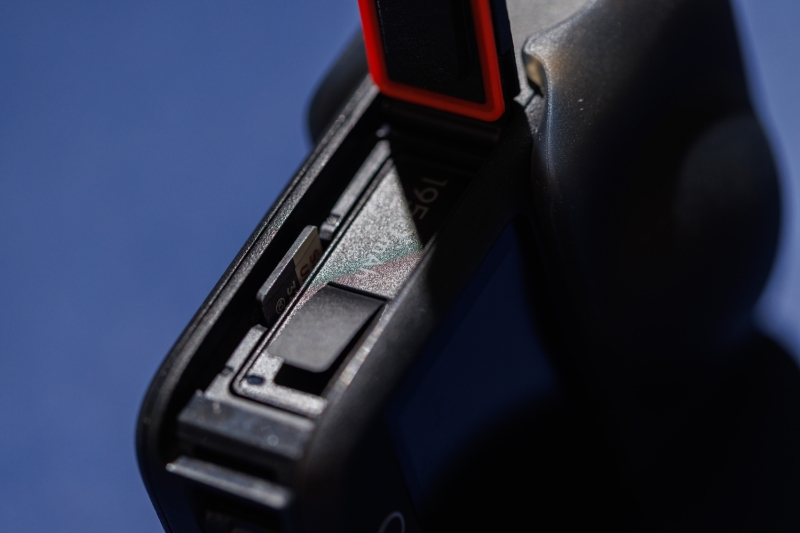
Tight microSD card slot inside the battery compartment.
On the bottom, you’ll also find the magnetic quick‑release mount—compatible with DJI’s Osmo Action accessory system—and a standard 1/4‑inch thread for broader mounting options to easily switch between immersive 360° shots and single‑lens selfie vlogging.
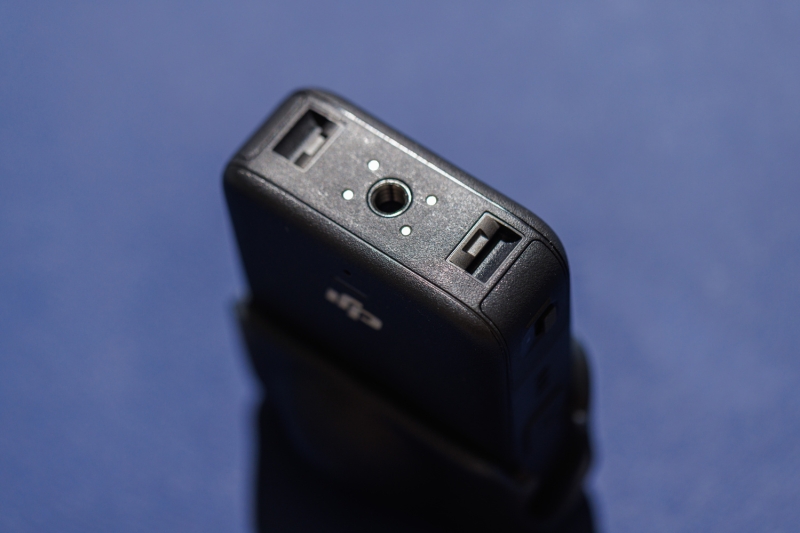
DJI’s Osmo Action magnetic quick‑release mount, 1/4‑inch thread, and charging points for DJI’s Battery Extension Rod found under the Osmo 360.
Features
One headline‑grabbing innovation of the Osmo 360 is its industry‑first square sensor—a smart engineering choice worth attention. Instead of using a conventional 4:3 rectangular sensor and cropping unused areas, DJI rethought sensor geometry by trimming it to a 1:1 square format, resulting in a more efficient 1/1.1‑inch effective sensor that retains the benefits of a full 1‑inch sensor while improving dynamic range and low‑light image quality thanks to effectively larger 2.4 μm pixels. It may sound technical, but in layman’s terms: DJI preserved most of the usable sensor surface while cutting waste, reducing power consumption as a bonus.

With dual 1‑inch sensors and an f/1.9 aperture, the Osmo 360 performs noticeably well in low light. While it’s not on par with a mirrorless camera, footage holds up with strong detail, balanced exposure, and minimal noise—even in less‑than‑ideal lighting. The camera claims 13.5 stops of dynamic range, which is impressive given its sensor size.
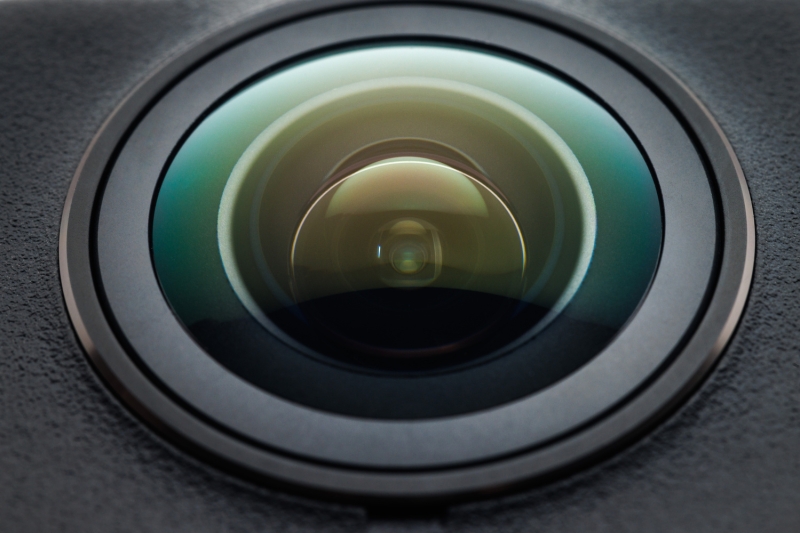
Thanks to the efficient square HDR sensor, the Osmo 360 can record up to 100 minutes at 8K/30 fps on a single charge. For a small 360 camera pushing such high resolution, that’s remarkable battery management. It reflects how the re‑engineered sensor boosts image quality and helps reduce power consumption during demanding shoots.
For more power, the Osmo 360 works with DJI’s Battery Extension Rod—it doubles runtime and charges the camera during long shoots, like timelapses. With it, you can operate the camera without the battery inserted, which may aid cooling—but I don’t recommend it, since accidental disconnection stops operation. In my experience, extended battery life via the rod removed my power anxiety and even added extended control buttons on the grip. I suspect that if the rod battery fully drains, grip controls may stop—but so far, it hasn’t reached that point. One caveat: the grip can show slightly in frame, so you’ll want awareness of your setup.
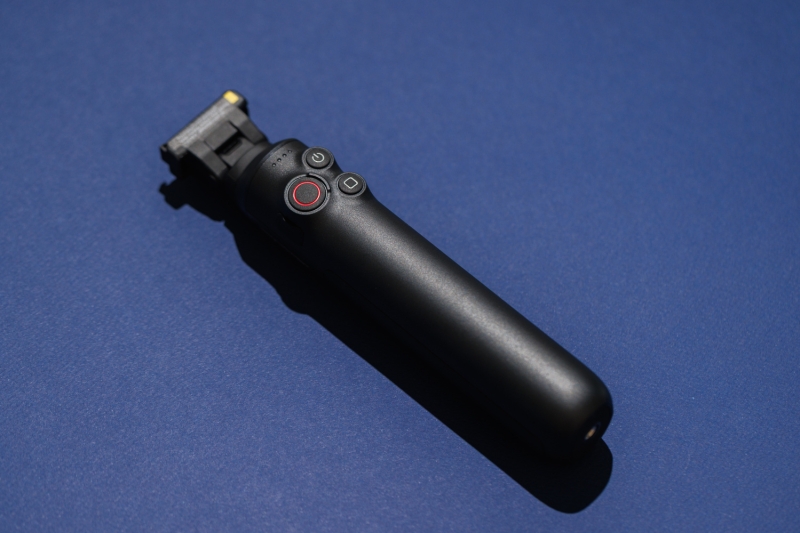
DJI’s Battery Extension Rod. Available as an optional add-on accessory.
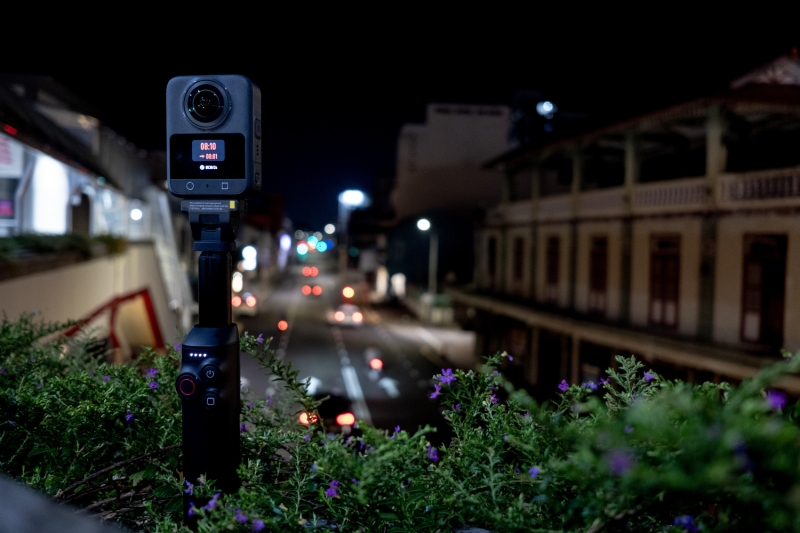
DJI’s Battery Extension Rod in use during timelapse recording. It was charging the camera while it was running the timelapse.
That said, the camera does get noticeably warm after around 20 minutes of continuous 8K recording, which is normal considering that it does not have any vents for cooling. While this has not caused operational issues in my experience, it is something to keep an eye on for extended shoots in humid environments where airflow is limited. There is also 105 GB of internal storage, which I think is a practical addition that can serve as a backup to keep the camera running even when we forget our microSD card or when it runs out of space. File transfer is equally efficient when using the included USB-C to USB-C PD cable (USB 3.1), which supports speeds up to 600 MB/s.
The camera also offers a full suite of creative shooting modes catering to various shooting conditions: 4K up to 100fps panoramic video, 120 MP 360° photos, single-lens video of 5K up to 60fps 4:3, hyperlapse, and time-lapse modes. Features like Gesture and Voice Control, HorizonSteady, RockSteady 3.0, GyroFrame, and intelligent tracking provide ease of use while still offering precise control over footage. The Osmo 360 also supports seamless front and back lens switching when filming in a single-lens mode for vlogging-style footage, and thanks to the integration of the DJI ecosystem, it allows the Osmo 360 to pair with the DJI Mic 2 or Mic Mini for wireless audio recording without a physical receiver.
For creators who work across platforms, the Osmo 360 integrates well into DJI’s existing ecosystem. Footage can be imported and edited via the DJI Mimo app or the more advanced desktop app, DJI Studio. Meanwhile, for those who use Adobe Premiere Pro, DJI also offers a plugin catering to more professional workflows. This ecosystem integration pushes the envelope of what a traditional 360 camera can do.
Real-World Usage and Examples
What I enjoy most about using the Osmo 360 is how it changes the way I think about image-making. It’s not about chasing perfect image quality or traditional framing—it’s about creating freely and experimenting in ways that break boundaries. With a camera this small and versatile, you stop worrying about the usual rules and start thinking in terms of spatial possibilities, movement, and placement. It allows us to explore angles and perspectives that would be difficult or impossible with conventional gear. For example, suspending the camera a few meters up with the 2.5 m selfie stick greatly expands its usability—just be aware of your surroundings when doing that. The shift in mindset away from technical precision and toward spontaneous creation is where the real strength of this camera lies.
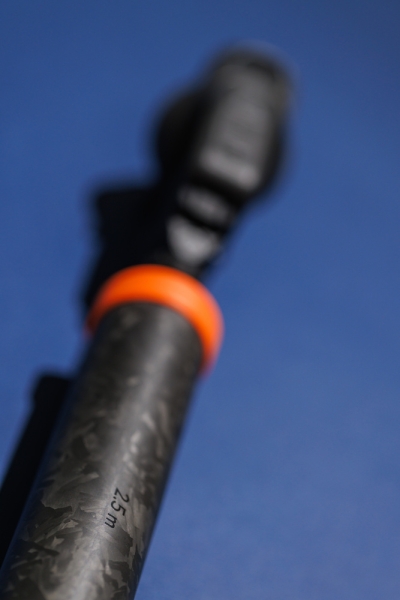
2.5 m extended selfie stick for Osmo 360. Also available as an optional add-on accessory.
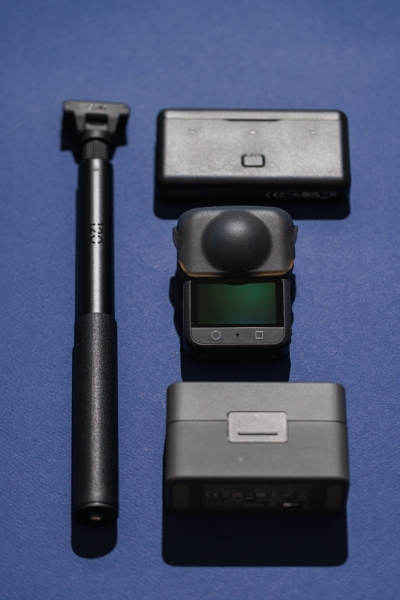
A compact setup to kickstart your content creation journey.
I would not have believed that this is all you need to start content creation—a compact 360° camera (Osmo 360) capable of filming all angles and a wireless mic (DJI Mic Mini) capable of receiving good audio. Adding their respective charging cases gives you enough power for extended hours of filming. Its ease of operation makes it a rather transparent device, outputting the idea we have in our brain with no boundaries. Being such a compact size also makes it ideal for placing in tight or unusual locations—high angles, low floor shots, poles, corners. The Osmo 360’s 2-inch touchscreen is reliable and bright enough to preview framing even in backlit conditions, making it a standalone device. While operation control with the app is not necessary, it is highly recommended for easier and more seamless control, especially when the camera is in an inconvenient location. My favorite way of using the camera is with the battery extension rod, as it allows me to control the camera from an extended length while not needing to rely on the app.
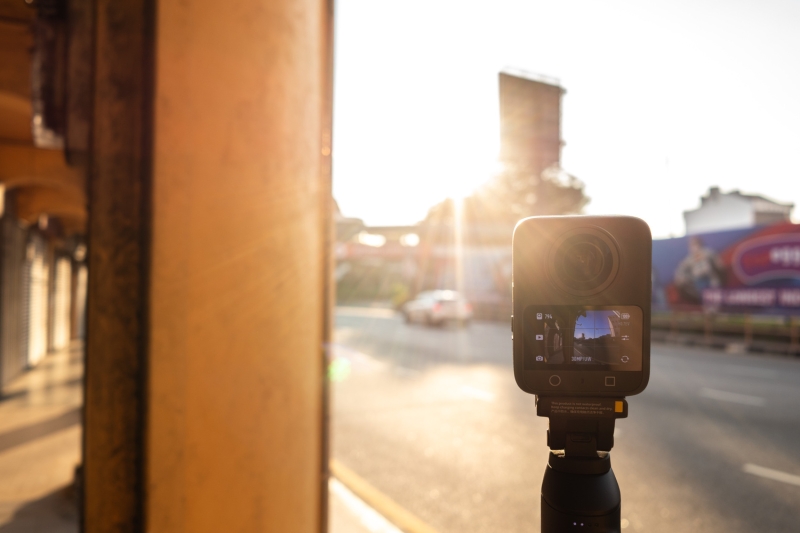
Osmo 360 screen under backlit situation.
Being a photographer first, I gravitated toward testing the photo capabilities, especially when it is such a small and unassuming camera. Despite being a camera that breaches boundaries, the results gave me mixed feelings. The raw output from the single-lens 12 MP photo mode with standard POV looks underwhelming, comparable to a smartphone output from more than a decade ago. I suspect this is due to the massive cropping from a 180° fisheye view to a “normal” view and edge stretching, which causes severe loss of image quality. This is also probably why the single-lens 30 MP wide-angle mode fares slightly better. There is also a noticeable shutter lag, and no way to set the focus point. While it is not usually needed for a camera this wide, focus shifts are quite visible with closer subjects. While the image from the single-lens mode may leave room to improve, the 120 MP 360° image is pretty good with no weird exposure variance and no obvious stitching error if there are no close-up subjects, though they are only available in JPEG format. That said, there is still something liberating about photographing with such a camera. While it was not designed for it, it removes some pressure from the creative process and invites experimentation we might normally avoid, even if the results are imperfect.
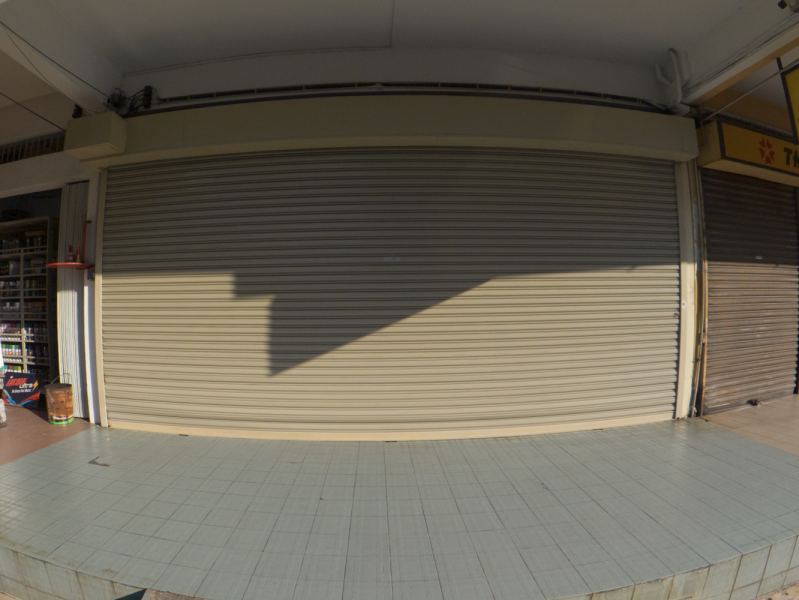
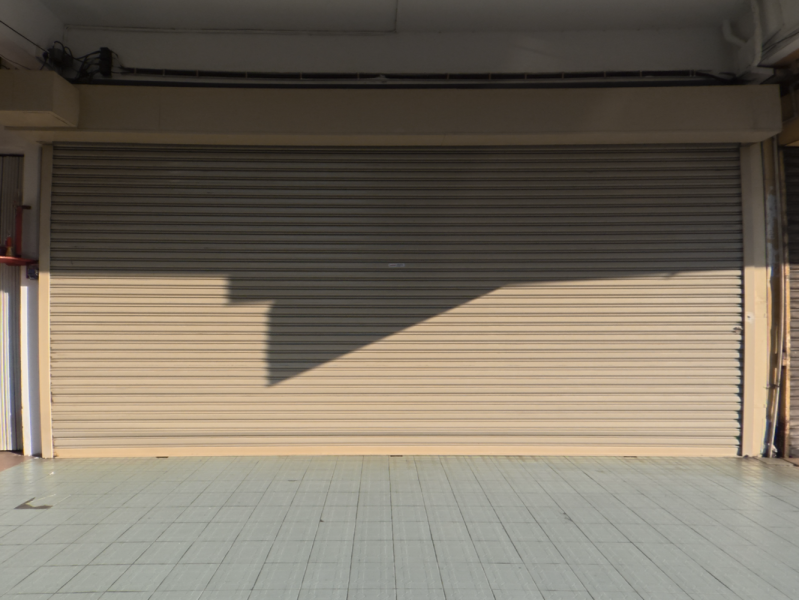
Images shot with Osmo 360 using the single lens mode.
Now let’s talk about video, which is where I think the strength of the Osmo 360 lies, as the experience is far more refined. The Osmo 360 is the first 360-degree camera capable of recording 8K up to 50fps panoramic video. Unlike traditional video cameras, having high resolution is important in 360-degree video as you will likely conform the video into a 2D video, previewing a small section of the entire frame, effectively losing most of its resolution. Even with 8K resolution, I found myself wanting more resolution after conforming the video. The video from the single-lens mode at 5K resolution is usable, though it may look a little glowy, which some may like for the “cinematic” look. I found the 4:3 format on the single-lens video quite useful, especially if trying to match the open-gate video output from, say, the Panasonic GH6. Personally, the low-light video performance is okay, but I would not film with ISO above 3200, with ISO 6400 and 12800 for emergency use only.
Colors of the video are good straight out of the camera, even with auto white balance, possibly helped by the 10-bit color recording. Recording in D-Log M profile is highly recommended, as I found the colors slightly better than standard profile after conversion, while also preserving all the dynamic range for post flexibility. Exposing for 360-degree footage can be tricky due to the extreme tonal range between bright skies and shaded ground, but with some exposure compensation, the sensor handles it well. While some users report that the Osmo 360 overheats, it did not happen to me, as I was able to continuously record for 1 hour 23 minutes with around 800 MB left in the built-in memory before I drained the battery. I did have the auto turn-off display setting on, and I was recording 8K/30fps at room temperature.
While I usually dislike recording in Auto mode, I found usability advantages baked into Auto mode with the Osmo 360. It transitions smoothly between exposure levels in high-contrast scenes. The anti-motion blur feature, which manages unwanted motion blur, is only available in Auto mode. I also found the RockSteady electronic image stabilization when recording in the single-lens mode to be good—just make sure your shutter speed is high enough to get enough frames for compensation. However, I would avoid Endurance Mode, as there is a noticeable compromise on image quality in low-light conditions in exchange for some battery life.
Unless I am planning to make a time-lapse that covers an extended period, I prefer shooting in Hyperlapse mode over Time-Lapse mode. The camera’s Time-Lapse mode only outputs video in a standard compressed profile, with no access to the individual raw or JPEG images or D-Log M profile. Hyperlapse, on the other hand, retains the flat profile for flexibility in post but at the cost of not getting enough organic motion blur for slower subject movement, as you cannot drag the shutter enough, and possibly a heavier toll on the battery as it is constantly recording the footage to be sped up later.
The 105 GB internal storage feels sufficient for my usage, and I never felt the need to have a microSD card. For extended filming where you have no access to your computer, it is recommended to have expandable storage so you can quickly swap cards when full. Despite not using a microSD card, transferring the footage out of the camera is simple and fast. Keep in mind the camera must be powered on to initiate the file transfer, and using the provided USB 3.1 Type-C data cable is recommended. The biggest weakness is the file format in which the video is saved. As I mainly edit videos in DaVinci Resolve, I was not able to import the OSV file format from the Osmo 360 without first converting it with DJI Studio v1.0.2. The conversion time can be long—it took me almost an hour to export a total of nine minutes of panoramic video of varying frame rates. Note that there is a plugin for Adobe Premiere Pro, but I could not test whether it reads the OSV format directly as I do not own the software.
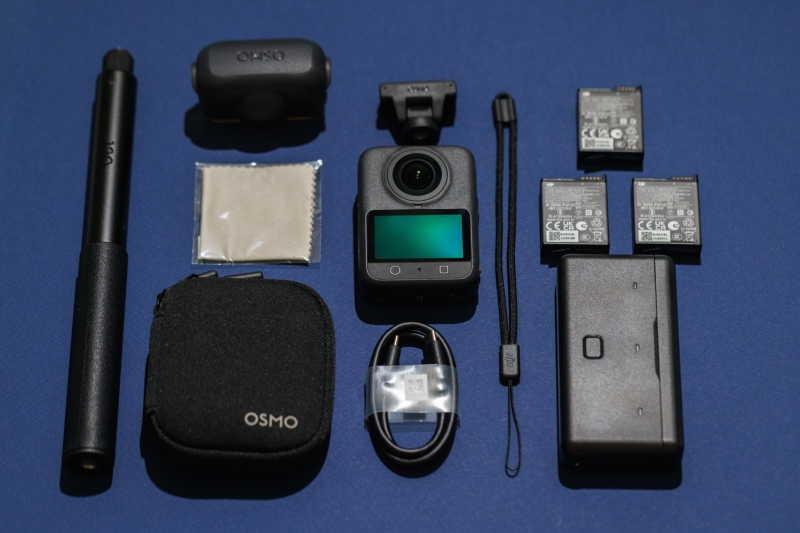
What you will get with the Adventure Combo.
For those who get the Adventure Combo, the Osmo Action Multifunctional Battery Case 2 is probably my favorite accessory DJI has made. It conveniently stores and charges your extra batteries and also doubles as a power bank, though DJI does not officially advertise that functionality—I have tested it, and it works. Lastly, an unofficial tip for those who run out of power when filming and are desperate: you can continue filming with USB-C charging, but keep in mind that since the protective flap is open, the camera is no longer waterproof.
Summary
What I Liked
-
Flexible 360-degree point of view with video recording of 8K/50fps and 120 MP photos
-
10-bit color and D-Log M video recording
-
105 GB of built-in internal storage
-
Compact size and light weight
-
Access to quick instant recording even when powered down
-
Smart Multifunctional Battery Case 2 for convenient battery storage and charging, also acting as an emergency power bank
-
DJI ecosystem integration, including compatibility with DJI wireless mics, DJI Osmo Action 5 Pro battery sharing, and mounting accessories
-
Great usability and user experience
What Could Be Improved
-
microSD card slot position
-
No replaceable lenses
-
The protective pouch does not fit the camera with the rubber lens protector on
-
Recording format in the OSV file, which is hard to edit and view on non-proprietary software
-
Photo quality on the 12 MP single-lens photo mode
-
No manual focus point selection
-
Shutter lag reduces responsiveness in photo mode
-
Time-lapse does not output individual raw images
Closing Thoughts
It was hard to find serious faults with the Osmo 360. There are a few quirks and limitations, but none hinder usability or affect its operation in achieving its creative potential. Despite covering so much, I felt I was barely scratching the surface of what’s possible with this camera. Toward the end of the review, there was little emphasis on technical perfection—instead, I was pushing the boundaries of what I could create with it.
The real power of a portable 360 camera is not in creating traditional 360° videos, but in how it lets us simulate multi-camera angle setups, unlock dynamic movements by reframing shots in post, all from a single take. It’s a camera that encourages play, experimentation, and rethinking how scenes are captured.
With tools like this, you are more likely to run out of storage or battery before you run out of ideas. The more time you spend with it, the more creative doors it opens—it depends on how far you’re willing to push.
The Osmo 360 isn’t trying to be your main video rig or replace a dedicated photo camera. Instead, it’s built to be fast, fun, and flexible. For someone like me, who often approaches gear from a photographer’s perspective, it may not shine in stills, but as I am exploring my place in the video world, it absolutely earns its place. For those who are interested, get yours today starting from $549.99 (Standard Combo) or $699.99 (Adventure Combo).
